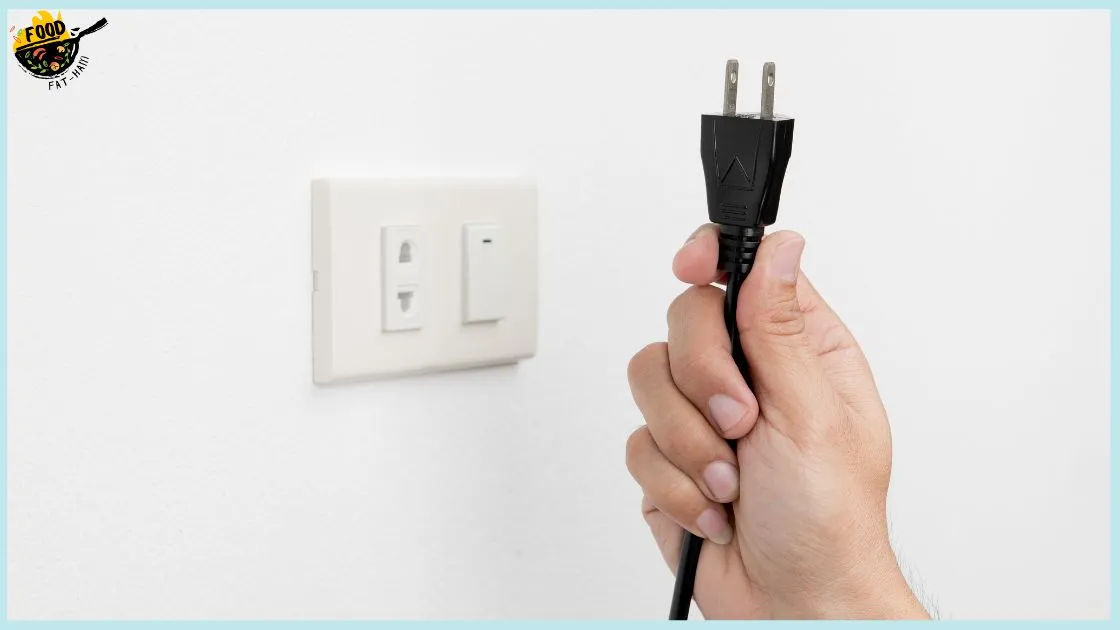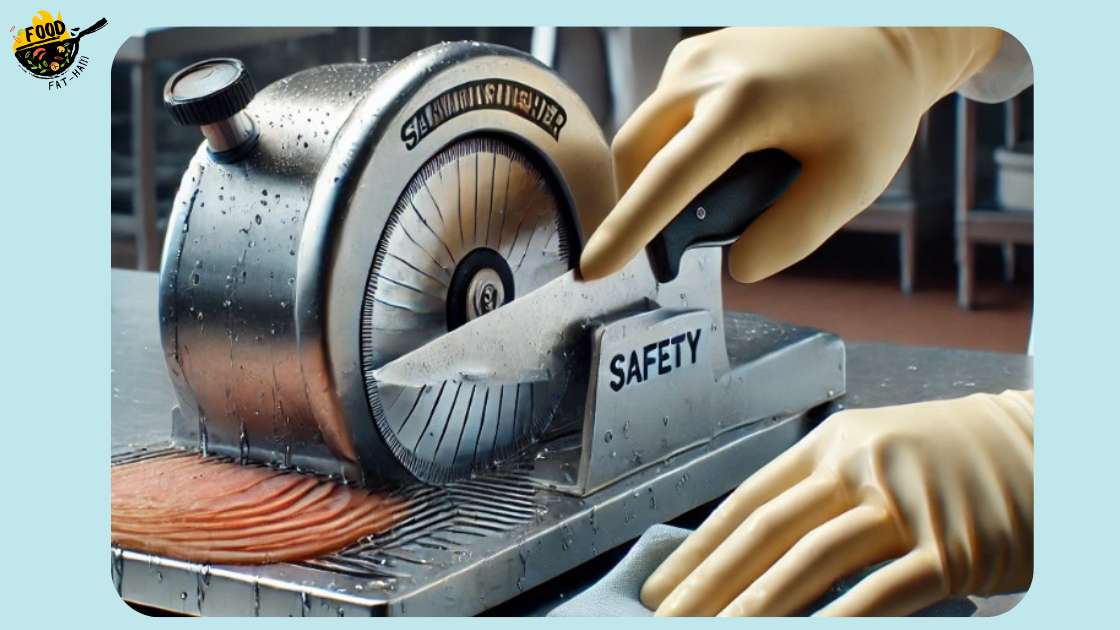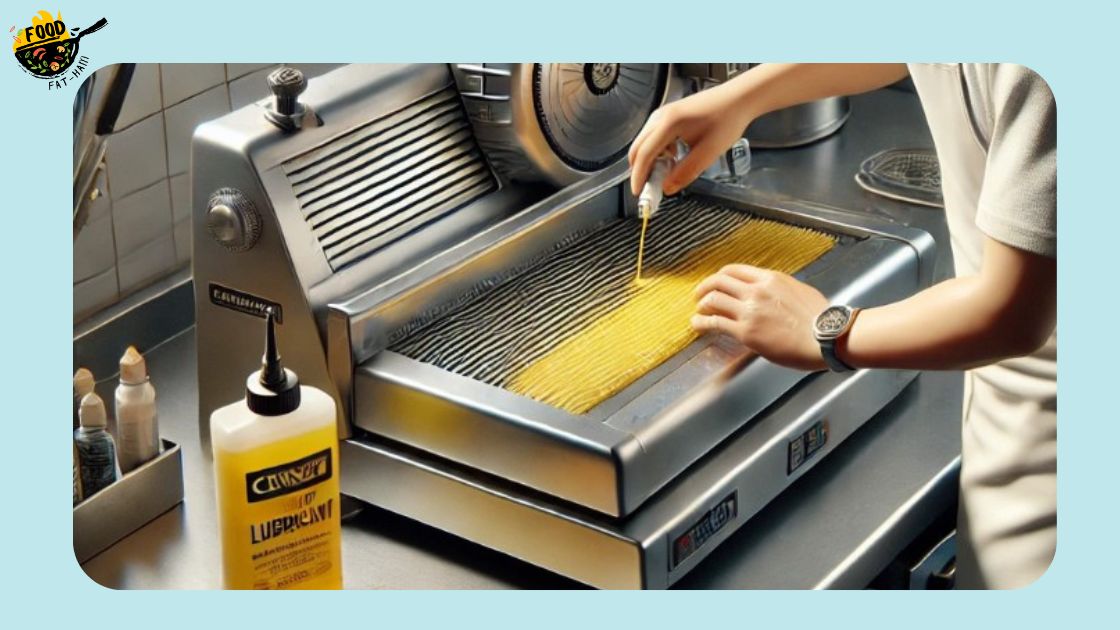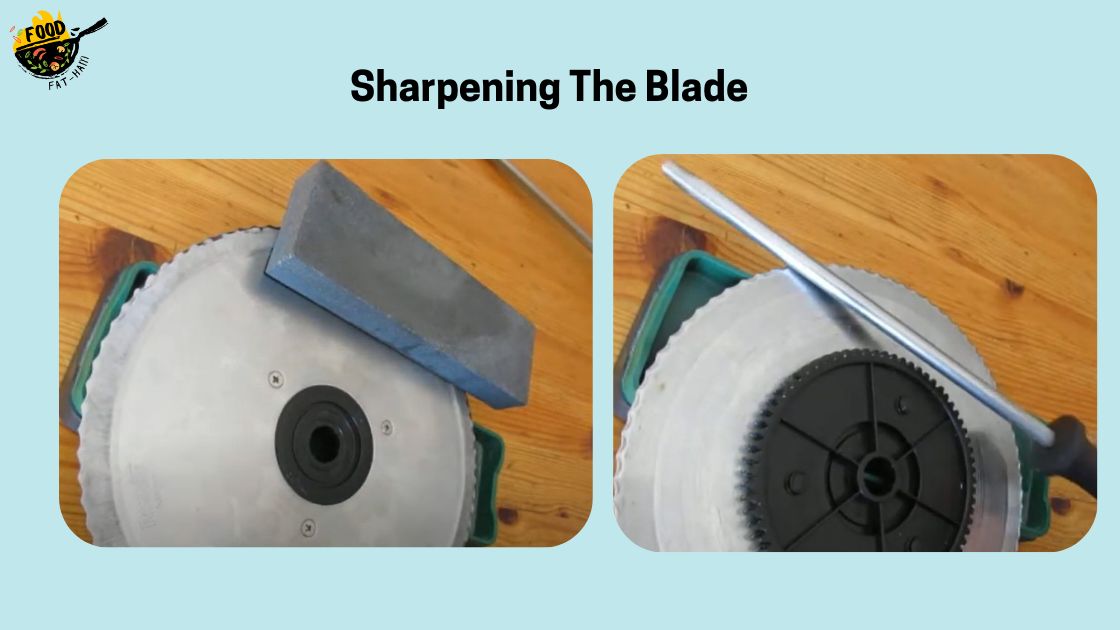To clean a deli slicer, follow these steps: Disconnect the slicer’s power supply and carefully remove the blade, soak it in warm soapy water, scrub off any debris, rinse thoroughly, and dry before reassembling. Cleaning a deli slicer is essential to maintain hygiene and prevent cross-contamination.
Table of Contents
ToggleNeglecting regular cleaning can lead to the buildup of bacteria and affect the slicer’s performance. It is important to clean the deli slicer after each use to ensure safe and efficient food preparation. Regular maintenance and cleaning will extend the lifespan of the slicer and keep it in optimal condition, ready for future use.
Importance Of Regular Cleaning
Regular cleaning of a deli slicer is crucial to maintain hygiene and prevent cross-contamination. By following proper cleaning techniques and using disinfectants, you can ensure the safety of food preparation and prolong the life of the slicer.
Regularly cleaning a deli slicer is essential for several reasons. It not only helps to avoid cross-contamination but also maintains the efficiency and performance of the equipment. Additionally, it ensures food safety, protecting both customers and staff from potential health risks.
In this section, we will delve into the importance of regular cleaning, focusing on three key aspects: avoiding cross-contamination, maintaining equipment efficiency and performance, and ensuring food safety.
Avoiding Cross-Contamination:
- Cleaning the deli slicer after each use removes any bacteria or food particles that may have accumulated on its surface.
- Cross-contamination can occur when different types of food come into contact with each other, leading to the spreading of harmful microorganisms.
- Proper cleaning and sanitizing of the deli slicer reduce the risk of cross-contamination and help maintain a safe and hygienic food preparation environment.
Maintaining Equipment Efficiency And Performance:
- Regular cleaning prevents the buildup of residue, such as oils, fats, and food debris, on the slicer’s blades and other components.
- Accumulated residue can cause the blades to become dull or sticky, impacting the slicer’s cutting performance.
- By cleaning the slicer regularly, you ensure that it operates at its best, allowing for smooth and precise slicing.
Ensuring Food Safety:
Food safety is a top priority in any food establishment. Regular cleaning of the deli slicer plays a crucial role in preventing foodborne illnesses.
Bacteria, viruses, and other pathogens can contaminate the slicer during use, potentially transferring onto sliced foods.
Thoroughly cleaning and sanitizing the slicer eliminates these harmful microorganisms, reducing the risk of foodborne illnesses and ensuring safe consumption.
Regularly cleaning a deli slicer is not only necessary for hygiene purposes but also for maintaining the slicer’s functionality and preserving food safety. It helps to prevent cross-contamination, maintain efficient equipment performance, and uphold the highest standards of food safety.
By incorporating regular cleaning practices into your deli’s routine, you can ensure the well-being of your customers and the overall success of your establishment.
Tools And Materials Needed
Cleaning a deli slicer requires a few essential tools and materials to achieve proper hygiene. These include a mild detergent, a soft brush, a clean towel, and food-grade sanitizer for thorough disinfection. Following the recommended guidelines will ensure a clean and safe deli slicer for use.

Cleaning a deli slicer requires specific tools and materials to ensure thorough cleaning and a hygienic environment.
Here are the essential items you’ll need:
- Cleaning solution: A suitable cleaning solution is vital to remove grease, food particles, and bacteria effectively. Look for a commercial slicer cleaner or create your own solution by mixing warm water with a mild detergent or sanitizing agent. Avoid using abrasive cleaners that could damage the slicer’s components.
- Microfiber cloth: A soft microfiber cloth is ideal for wiping down the slicer’s surfaces. Its fine fibers effectively capture dirt and grime without leaving behind lint or scratches. Make sure to have a few clean microfiber cloths available for each cleaning session.
- Cleaning brushes: Deli slicers have various crevices and hard-to-reach areas that require scrubbing. Use different sizes of cleaning brushes, such as a small brush for intricate parts and a larger brush for larger surfaces. These brushes aid in loosening and removing tough stains and debris.
- Gloves: Keeping your hands protected during the cleaning process is crucial. Opt for sturdy, food-grade gloves to shield your hands from any potential injuries and to prevent contamination. Disposable gloves are a convenient option as they can be discarded after use.
Remember, these tools and materials are essential for ensuring a thorough and efficient cleaning process for your deli slicer.
Preparing The Deli Slicer
Learn how to properly clean and maintain your deli slicer for optimal performance. Follow these step-by-step instructions to ensure a hygienic and safe slicing experience.
Disconnecting The Power Source

Before you begin cleaning your deli slicer, it is crucial to disconnect the power source to ensure your safety. Here’s how you can do it:
- Turn off the power switch located on the slicer’s control panel.
- Unplug the slicer from the electrical outlet.
Remember, always prioritize your safety by disconnecting the power source before proceeding with the cleaning process.
Dismantling Removable Parts
To effectively clean your deli slicer, you need to dismantle the removable parts. This step allows you to reach all the nooks and crannies where food particles and grease might have accumulated. Follow these steps:
- Remove the sharp blade or cutting edge by loosening the blade lock knob or using a wrench if required. Be cautious while handling the sharp blade to prevent injuries.
- Take out the blade cover if your slicer has one. This will expose the blade for better accessibility during cleaning.
- If applicable, remove the product tray or food pusher that sits on the slicer’s carriage. This will give you access to other parts that need cleaning.
- Detach any other removable parts specified in the manufacturer’s instructions, such as the thickness plate or deflector.
By dismantling these parts, you can effectively clean every component of your deli slicer, ensuring optimal hygiene and performance.
Removing Food Residue
To clean a deli slicer and remove food residue, follow these simple steps: Unplug the slicer and disassemble the parts, wash them with warm soapy water, use a scrub brush to remove stuck residue, rinse and sanitize the parts, and make sure everything is completely dry before reassembling.
It’s important to keep your deli slicer clean to ensure food safety and prevent cross-contamination.
Using A Microfiber Cloth To Wipe Away Excess Food:
- Start by unplugging the deli slicer and ensuring that it is switched off.
- Take a clean microfiber cloth and gently wipe away any visible food residue on the slicer’s surface.
- Pay special attention to the blade area, removing any lingering food particles or grease.
- Use small circular motions to effectively clean the slicer and prevent scratching.
- If necessary, dampen the cloth with warm soapy water for a more thorough cleaning.
- Rinse the cloth and wring out excess water before wiping down the slicer again.
- Ensure that all food residue is completely removed before proceeding to the next step.
Removing Stubborn Residue With A Cleaning Solution:
- Prepare a cleaning solution using warm water and a mild dish soap or cleaning agent suitable for food equipment.
- Dip a clean microfiber cloth into the cleaning solution, making sure it is damp but not dripping.
- Gently scrub the slicer’s surface, focusing on areas with stubborn residue or build-up.
- Pay close attention to corners, crevices, and the blade edge where residue often accumulates.
- For tough residue, allow the cleaning solution to sit on the surface for a few minutes before scrubbing again.
- Rinse the cloth and wring out excess water, then wipe down the slicer to remove any soap residue.
- Dry the slicer thoroughly with a clean and dry microfiber cloth to prevent water spots or rust.
Remember, regular cleaning and maintenance of your deli slicer will help ensure food safety and prolong its lifespan. Happy slicing!
Cleaning The Blade
Regularly cleaning the blade of your deli slicer is crucial for maintaining food safety and longevity. Follow these steps to keep your deli slicer clean and in optimal condition.

To ensure that your deli slicer is clean and ready for use, it’s important to pay special attention to cleaning the blade. This part of the slicer can easily accumulate food particles and grease, so a thorough cleaning is necessary.
Follow these steps to clean the blade effectively:
Applying Cleaning Solution Directly Onto The Blade:
- Start by unplugging the slicer and ensuring that it has completely stopped moving.
- Carefully apply a small amount of cleaning solution directly onto the blade, covering the entire surface. This will help to break down any stubborn residue that may be present.
- Allow the cleaning solution to sit on the blade for a few minutes to loosen any grease or grime.
- Using a clean cloth or sponge, gently wipe the blade in a back-and-forth motion to remove the loosened residue.
- Be cautious when handling the blade to avoid any accidents or injuries.
Using A Cleaning Brush To Scrub The Blade Carefully:
- Once you have wiped away the initial residue, it’s time to use a cleaning brush to scrub the blade more thoroughly.
- Choose a brush with soft bristles to avoid scratching the blade surface.
- Starting at one end, carefully scrub the blade in a circular motion, ensuring that you cover the entire surface.
- Pay extra attention to any areas that may have accumulated more residue, such as the edges or corners.
- Rinse the blade with warm water to remove any remaining cleaning solution and residue.
Ensuring No Residue Is Left On The Blade:
- After scrubbing the blade, it’s crucial to check for any remaining residue.
- Inspect the blade carefully, looking for any leftover particles or greasy spots.
- If you spot any residue, repeat the cleaning process by applying more cleaning solution and using the brush to scrub it off.
- Once you are satisfied with the cleanliness of the blade, rinse it thoroughly with warm water.
- Finally, dry the blade completely before reassembling the deli slicer.
By following these steps and properly cleaning the blade of your deli slicer, you can maintain its performance and ensure that your sliced meats and cheeses are always fresh and uncontaminated. Remember to exercise caution when handling the blade to prevent any accidents.
Cleaning Removable Parts
Learn how to clean a deli slicer by effectively cleaning its removable parts. Maintain hygiene and ensure the slicer’s longevity with these easy cleaning tips.
Cleaning a deli slicer requires attention to detail to ensure food safety and optimal performance. One crucial aspect is properly cleaning the removable parts. Follow these steps to effectively clean the removable parts of your deli slicer:
Soaking removable parts in a cleaning solution:
Fill a container with warm water and add a mild dish soap or commercial deli slicer cleaning solution. Immerse the removable parts, such as the blade, guard, and food carriage, in the solution. Allow the parts to soak for approximately 10-15 minutes to loosen any food residue.
Scrubbing with a cleaning brush to remove any debris:
After soaking, use a cleaning brush, preferably with stiff bristles, to scrub each part thoroughly. Pay close attention to crevices and hard-to-reach areas where food particles may accumulate. Ensure that all visible debris and residue are completely removed.
Drying thoroughly before reinstallation:
Once the parts are clean, rinse them thoroughly with clean water to remove any remaining soap or cleaning solution. Use a clean towel or air dry the parts to ensure they are completely dry before reinstallation. Moisture can lead to bacterial growth, so it is vital to eliminate all traces of moisture.
Remember to handle the sharp components with caution throughout the cleaning process to prevent any accidents. Cleaning your deli slicer’s removable parts regularly will help maintain its performance, extend its lifespan, and ensure safe food preparation.
Cleaning The Housing And Motor
To clean a deli slicer, start by disconnecting the power source. Then, remove the housing and motor and clean them with warm soapy water, making sure to dry them thoroughly before reassembly. Remember to follow the manufacturer’s instructions for safe and proper cleaning procedures.
Keeping your deli slicer clean is essential for maintaining food safety and prolonging the lifespan of the equipment. One crucial aspect of cleaning is focusing on the housing and motor areas. Here’s a step-by-step guide on how to clean these parts effectively:
Wiping down the housing with a cleaning solution:
To start, prepare a mild cleaning solution by mixing warm water with a small amount of dish soap.
Follow these steps:
- Dip a clean cloth into the cleaning solution.
- Wring out any excess moisture from the cloth.
- Gently wipe down the housing of the deli slicer, paying attention to any areas with visible spills or grime.
- Be thorough in cleaning all the surfaces, including the exterior sides and corners.
- Ensure the cloth is damp and not soaking wet to prevent water damage to the equipment.
Using a clean cloth to remove any remaining solution:
Once you have wiped the housing with the cleaning solution, it’s important to remove any residue left behind.
Follow these steps:
- Take a separate clean cloth and dampen it with fresh water.
- Wipe down the housing again, this time removing any remaining cleaning solution.
- Pay attention to corners and hard-to-reach areas where residue might accumulate.
- Make sure to rinse the cloth frequently to avoid spreading dirt or debris.
Cleaning the motor area with a dry cloth:
The motor area is responsible for powering the deli slicer and needs proper maintenance.
Follow these steps:
- Take a dry cloth and use it to clean the motor area.
- Be gentle but thorough in removing any dust or particles that may have accumulated.
- Avoid using any cleaning solutions or water directly on the motor area, as it may damage the internal components.
- Pay close attention to vents or openings where dust tends to accumulate.
- Regularly check for any loose or frayed wires and address them accordingly.
Remember, regular cleaning of the housing and motor areas of your deli slicer is crucial for optimal performance and food safety. By following these steps, you can ensure that your deli slicer remains clean and in top-notch condition for its intended use.
Reassembling The Deli Slicer
Learn how to reassemble your deli slicer after cleaning it with these easy steps. Keep your deli slicer in top condition for safe and efficient slicing.
Now that you have thoroughly cleaned all the components of your deli slicer, it’s time to reassemble it.
Follow these steps to ensure proper reassembly, as per the manufacturer’s instructions:
Drying All Components Completely
To start the reassembly process, make sure all the parts of the deli slicer are completely dry. Use a clean towel or allow them to air dry to ensure no moisture remains, which can lead to rust or bacterial growth.
Take extra care to dry the blade, guard, and slicing tray thoroughly.
Following the manufacturer’s Instructions For Reassembly
Each deli slicer may have specific guidelines for reassembly, so it is essential to follow the manufacturer’s instructions. These instructions usually include step-by-step diagrams or written explanations to help you put all the components back together correctly. Pay close attention to any specific order or direction mentioned in the instructions to ensure proper functioning.
Here are the general steps you may encounter when reassembling your deli slicer:
Start by placing the blade back onto the slicer’s hub, making sure it aligns correctly. Attach the guard over the blade, ensuring it fits snugly and covers the sharp edges for safety.
Slide the slicing tray back into position, aligning it with the blade and guard. Secure any additional parts according to the manufacturer’s instructions, such as knobs, screws, or locks.
Remember, each deli slicer model may have unique specifications, so always consult the provided instructions to guarantee a successful reassembly.
Ensuring All Parts Are Securely In Place
Once you have followed the manufacturer’s instructions and reassembled the deli slicer, it is vital to check that all parts are securely in place. This step ensures safe and efficient operation during future use.
Here are the key points to keep in mind:
- Double-check that the blade is correctly positioned and firmly attached to the hub.
- Ensure the guard is properly secured over the blade, covering all sharp edges.
- Confirm that the slicing tray is aligned with the blade and fits securely.
- Verify that any additional parts, such as knobs or screws, are tightened appropriately.
By ensuring all parts are securely in place, you can avoid potential accidents and ensure smooth slicing performance with your deli slicer.
Remember, always refer to the manufacturer’s instructions for any specifications or guidelines specific to your deli slicer model. With proper reassembly, your deli slicer will be ready to use again, providing efficient slicing for your deli meats and other food items.
Regular Inspections
Regular inspections are crucial for maintaining the cleanliness of a deli slicer. By following a few simple steps, you can ensure that your slicer is kept in optimal condition and free from any potential hazards.
Regular inspections are essential for maintaining the cleanliness and proper functioning of your deli slicer. By conducting routine checks, you can identify any potential issues or signs of wear before they become more significant problems.
Here are some key areas to focus on during your regular inspections:
- Checking for any damage or signs of wear: Inspect the overall condition of the deli slicer for any visible damage or signs of wear. Look for cracks, dents, or any loose parts that may affect its performance. Pay attention to the blade, ensuring there are no chips or nicks that could potentially contaminate the food.
- Tightening any loose screws or parts: Carefully examine the slicer for any loose screws or parts that may have come undone over time. Take the necessary tools and tighten them to maintain stability and prevent accidents during operation. Ensure that all components are securely fastened to guarantee smooth and safe slicing.
- Cleaning all the nooks and crannies: Use a brush or a cloth to reach into the corners, crevices, and hard-to-reach areas of the slicer. Remove any food residue or debris that may have accumulated. Pay close attention to the blade guard and carriage, as these areas tend to harbor bacteria and contaminants.
- Inspecting the blade’s sharpness: Regularly check the sharpness of the blade. A dull blade may not deliver clean, precise cuts and can potentially increase the risk of accidents. If you notice any signs of dullness, consider sharpening or replacing the blade.
- Checking for proper alignment: Verify that the blade and the slicer’s various components are properly aligned. Misalignment can affect the slicer’s performance and pose safety hazards. Make the necessary adjustments to ensure everything is properly aligned.
By performing regular inspections on your deli slicer, you can guarantee its cleanliness, functionality, and longevity. These straightforward checks will enable you to catch any potential issues early on, ensuring that your deli slicer operates at its best and provides safe and quality food preparation.
Lubrication
Regular lubrication is essential for maintaining the performance and longevity of your deli slicer. Cleaning the slicer thoroughly and applying lubricant to the moving parts will ensure smooth operation and prevent wear and tear over time.

Applying Food-Grade Lubricant To Necessary Areas:
Proper lubrication is essential for maintaining the performance and lifespan of your deli slicer. By regularly applying food-grade lubricant to the necessary areas, you can prevent corrosion and ensure smooth operation.
Here are the key steps to follow:
- Start by unplugging the deli slicer and ensuring it is completely turned off.
- Clean any residue or food particles from the slicer with a damp cloth or sponge.
- Identify the areas that require lubrication, such as the slide rod, blade, and pivot points.
- Apply a small amount of food-grade lubricant to these areas. It’s important to use a lubricant that is specifically designed for food equipment to ensure it is safe for consumption.
- Use a cloth or your fingers to spread the lubricant evenly and ensure it covers all the necessary surfaces.
- Pay extra attention to the blade, as it is the most crucial part of the slicer for smooth cutting.
- Once all the areas have been lubricated, wipe off any excess lubricant with a clean cloth.
- Plug in the slicer and turn it on to test the smoothness of the operation.
- If you notice any resistance or friction, repeat the lubrication process until the slicer moves freely.
Regularly lubricating your deli slicer will not only prevent corrosion but also enhance its performance. By following these simple steps, you can ensure that your deli slicer operates smoothly and efficiently every time you use it.
Sharpening The Blade
Learn how to effectively clean your deli slicer and keep it in top condition with our guide on sharpening the blade. Discover the step-by-step process to maintain hygiene and functionality in your deli kitchen.

Keeping the blade of your deli slicer sharp is crucial for maintaining optimal cutting performance. Over time, the blade can become dull due to regular use. In this section, we will discuss the importance of scheduling regular blade sharpening or replacement to ensure your deli slicer operates at its best.
Scheduling Regular Blade Sharpening Or Replacement
- Regular maintenance: Just like any other cutting tool, deli slicer blades require regular maintenance to stay sharp. Determining the frequency of sharpening or replacement depends on the usage and condition of the blade. It is recommended to schedule it every few months or when you notice a decline in slicing efficiency.
- Professional assistance: While some individuals may prefer to sharpen the blade themselves, it is advisable to seek professional help. Professional technicians have the expertise and equipment to ensure the blade is properly sharpened or replaced, and they can identify any potential issues that may affect cutting performance.
- Replacement considerations: If your deli slicer blade is significantly damaged or worn out, it may be more cost-effective to replace it instead of sharpening it. Replacement blades are readily available and can provide a fresh cutting edge for improved performance.
- Maintenance logs: Keeping a maintenance log can help you track the frequency of blade sharpening or replacement, as well as other maintenance tasks performed on your deli slicer. This record can serve as a handy reference to ensure you stick to a regular schedule.
- Inspection and testing: Regularly inspecting the blade for any signs of wear or damage is essential. Additionally, testing the cutting performance before and after sharpening or replacement can help you gauge the effectiveness of the maintenance process.
By adhering to a regular blade sharpening or replacement schedule, you can ensure your deli slicer maintains optimal cutting performance, resulting in perfectly sliced deli meats, cheeses, and more. Neglecting blade maintenance can lead to subpar results and even potential safety hazards.
So, prioritize this aspect of deli slicer care to ensure your business continues to deliver top-quality food to your customers.
Importance Of Proper Deli Slicer Cleaning
Proper cleaning of a deli slicer is crucial to ensure food safety and prevent cross-contamination. Follow these steps to maintain a clean and sanitized slicer, ensuring the highest quality and safety standards are met.
Keeping your deli slicer clean is vital for several reasons. Proper cleaning not only helps prevent foodborne illnesses but also extends the lifespan of your equipment, saving you money in the long run.
Let’s explore these benefits in more detail
Preventing Foodborne Illnesses
Regular cleaning eliminates any residue or bacteria that may be present on the deli slicer, reducing the risk of cross-contamination and ultimately preventing foodborne illnesses.
Thoroughly cleaning the slicer after each use ensures that any potential pathogens are removed, providing a safe food-handling environment for both customers and employees.
Increasing The Lifespan Of The Equipment
- A clean deli slicer operates more efficiently and effectively, reducing the strain on its mechanical components and extending its lifespan.
- Removing food particles and grease prevents build-up, which can lead to corrosion or mechanical issues over time.
- Regular maintenance and cleaning prevent the accumulation of residue that can cause the slicer to become dull, resulting in poor slicing performance and a shorter lifespan.
By following proper cleaning protocols and regularly maintaining your deli slicer, you can ensure the safety of your food and customers while also prolonging the life of your equipment. It’s a win-win situation that guarantees both hygiene and cost-effective operation.
So, make cleaning your deli slicer a top priority to reap the benefits it offers.
Incorporating Cleaning Into Kitchen Routine
Keep your deli slicer clean by incorporating it into your kitchen routine. Regularly wipe down the slicer with a mild detergent, remove any food particles, and ensure all parts are thoroughly dry to prevent bacteria growth.
Maintaining cleanliness in a busy deli kitchen is essential for the health and safety of both staff and customers. A key aspect of this is ensuring that the deli slicer is regularly and properly cleaned. By incorporating cleaning into the kitchen routine, you can ensure that this important task is never overlooked.
Establishing A Cleaning Schedule
- Create a schedule: Designate specific times for cleaning the deli slicer to ensure it is done regularly.
- Assign responsibility: Clearly assign the task to a specific staff member who will be responsible for carrying out the cleaning.
- Consistency is key: Stick to the schedule consistently so that cleaning the deli slicer becomes a routine part of the kitchen operations.
Training Staff On Proper Cleaning Procedures
- Provide detailed instructions: Clearly communicate the proper cleaning procedures for the deli slicer to your staff.
- Demonstrate the process: Show your staff how to clean the slicer properly.
- Emphasize the importance of cleanliness: Explain to your staff why it is crucial to maintain a clean deli slicer to prevent cross-contamination.
Remember, the effectiveness of incorporating cleaning into the kitchen routine relies on consistency and proper training. By implementing a cleaning schedule and ensuring that all staff members understand and follow the proper cleaning procedures, you can maintain a clean and safe deli slicer for efficient and hygienic food preparation.
Frequently Asked Questions On How To Clean A Deli Slicer
What Are The Steps To Clean A Slicer?
To clean a slicer, follow these steps: 1. Unplug the slicer and remove any food debris. 2. Disassemble the slicer by removing the blade, guard, and other removable parts. 3. Wash the parts with warm, soapy water and scrub them gently.
4. Rinse the parts thoroughly and dry them completely before reassembling the slicer.
How Do You Clean A Deli Slicer Blade?
Clean a deli slicer blade by following these steps:
1. Unplug the slicer and remove residual food particles.
2. Soak the blade in warm soapy water for a few minutes.
3. Scrub the blade gently with a soft brush or sponge.
4. Rinse the blade thoroughly and dry it with a clean cloth.
How Often Does A Deli Slicer Need To Be Cleaned?
A deli slicer should be cleaned regularly, ideally after each use.
How Should Equipment Such as A Slicer Be Cleaned And Sanitized?
To clean and sanitize a slicer, follow these steps:
1. Rinse the slicer with warm water and detergent.
2. Use a brush to scrub off any residue or debris.
3. Sanitize the slicer with a food-safe sanitizer, following the instructions.
4. Allow the slicer to air dry or use a clean towel.
Remember to follow the manufacturer’s guidelines for cleaning and sanitizing your specific slicer model.
Conclusion
Keeping your deli slicer clean is not only essential for food safety but also for the longevity of your equipment. By following these simple steps, you can keep your deli slicer in top shape and ensure the quality of your food.
Regular cleaning with warm soapy water and a soft cloth should be done after each use to remove any food residue and prevent bacteria growth. It is also important to disinfect your deli slicer using a sanitizing solution or a mixture of water and bleach.
Don’t forget to lubricate the moving parts and regularly sharpen the blade for optimal performance. Remember to always follow the manufacturer’s instructions for cleaning and maintenance. By incorporating these cleaning practices into your routine, you can enjoy safe and efficient slicing for years to come.
So, don’t put off cleaning your deli slicer any longer – your delicious sandwiches and salads depend on it!



